Faculty Senate Remarks
President Joel Seligman
January 19, 2010
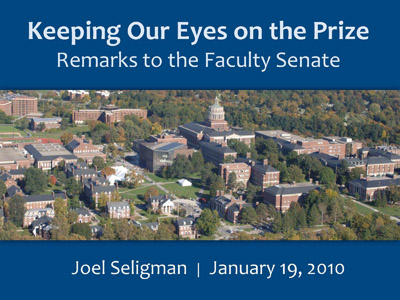
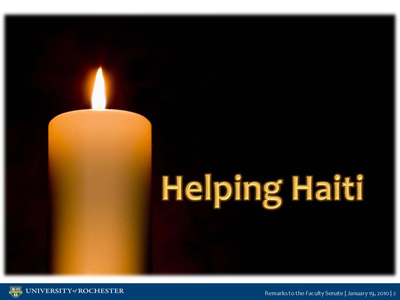
As with Hurricane Katrina a few years ago, this University is rallying to provide support in times of horrific humanitarian crises, particularly when as here, some of our students and alumni, are directly touched by this tragedy. In the days to come, there will be further communications from many parts of the University on how we can help. But I want to personally thank so many throughout the University who already have begun the process of aiding a stricken Haiti.
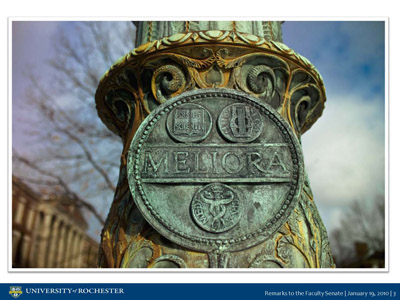
Since I last addressed the Faculty Senate on September 8, 2009, there has been much to celebrate at the University of Rochester.
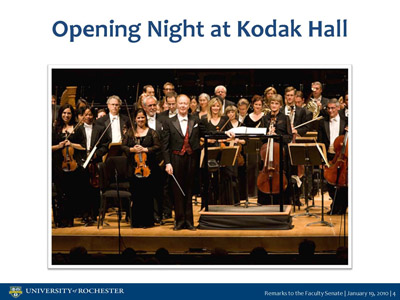
On October 8th, Kodak Hall at Eastman Theatre was opened with a sold out gala program and enthusiastic reviews.
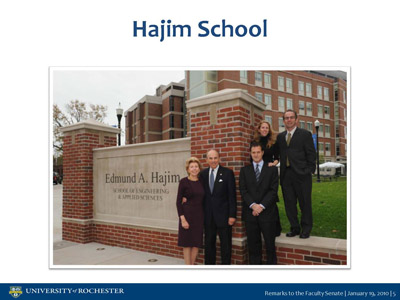
On October 9th, we officially dedicated the Edmund A. Hajim School of Engineering and Applied Sciences, honoring the largest single gift commitment in our history.
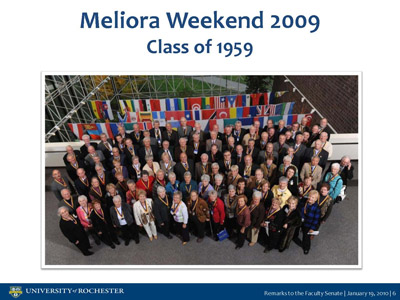
Meliora Weekend was particularly memorable for many reasons, including the largest single class gift in our history from the Class of 1959.
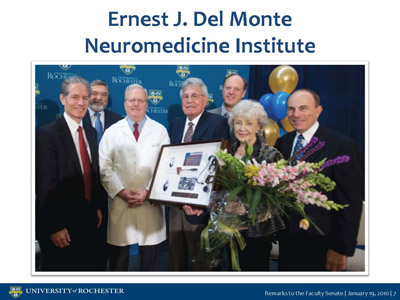
In December the University dedicated the Ernest J. Del Monte Neuromedicine Institute, recognizing Ernie and his family for a substantial commitment to a critical frontier in medical research.
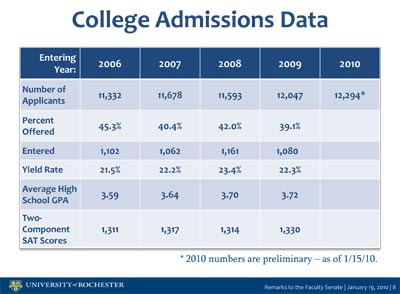
Applications to our undergraduate College program again have grown to a record level.
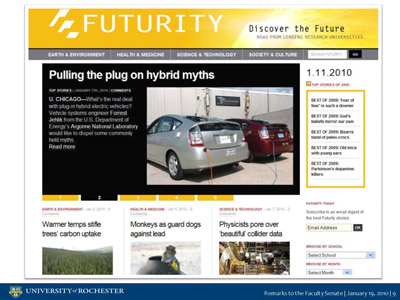
This fall University of Rochester Communications took the lead in developing and launching Futurity.org, a unique online research news magazine dedicated to showcasing the latest discoveries from leading research universities in the United States and Canada. The site is co-directed by Rochester, Duke and Stanford. In its first four months, Futurity has grown to represent 46 universities, featured more than 800 stories, had 312,000 visits and currently has close to 3,000 subscribers to its daily e-newsletter.
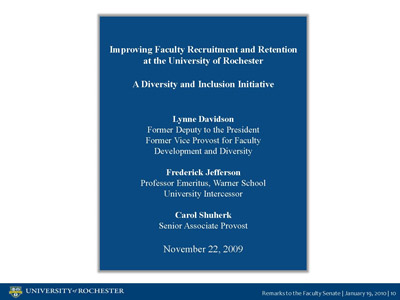
In December I officially received the report Improving Faculty Recruitment and Retention at the University of Rochester: A Diversity and Inclusion Initiative. I committed to attempting to implement its 14 recommendations, which include efforts to address faculty development, leadership support and organizational culture.
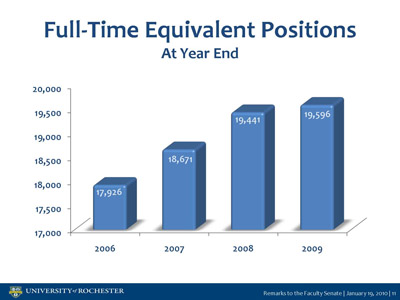
The University continues to strengthen Rochester’s economy through further job growth, although the rate of our growth slowed in 2009. Between December 2007 and December 2008 the University added 770 new faculty and staff jobs to total 19,441. This past year, during a challenging economy, 155 more new jobs were added. Most of these jobs are in our new Ambulatory Surgery Center. Our total Full-Time Equivalent employment was 19,596 on December 31, 2009.
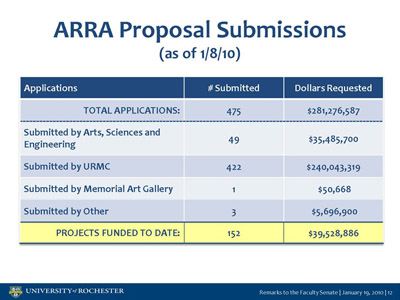
Through January 7th, 2010, the University of Rochester has received $39.5 million in American Recovery and Reinvestment Act awards for 152 proposals.
The achievements of our faculty and students have been stellar.
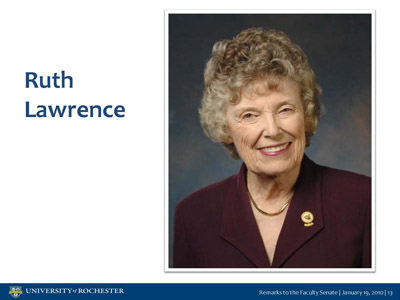
Ruth Lawrence, professor of Pediatrics and Obstetrics and Gynecology at our Medical Center, for example, was awarded the 2009 Martha May Eliot Award by the American Public Health Association for her tireless efforts to improve women’s and children’s health.
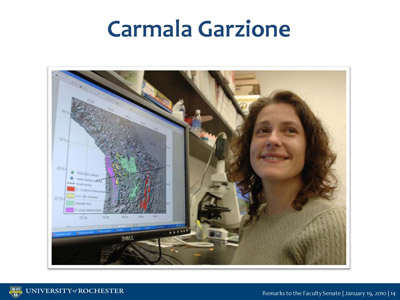
Carmala Garzione, associate professor of earth and environmental sciences, won the 2009 New York Academy of Sciences Blavatnik Award for research that has helped revise our understanding of how large mountain belts have a significant impact on global climate.
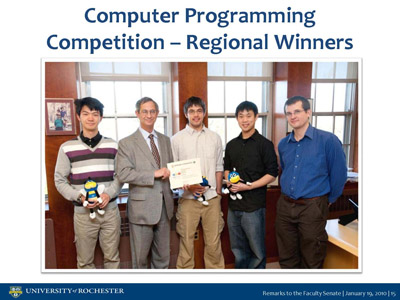
UR students defeated perennial winner MIT in the regional finals of the most prestigious international computer programming competition and will compete for the international title in Harbin, China in February.
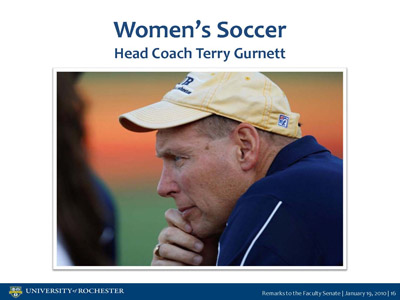
Women’s soccer head coach Terry Gurnett celebrated his 400th career win during a 33-year career, leading all Division III women’s soccer coaches in wins.
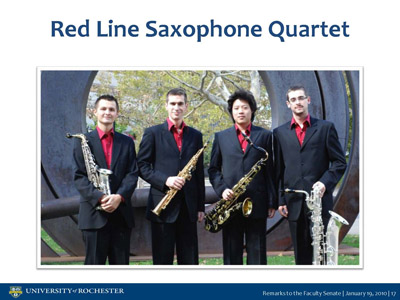
The Eastman School of Music’s Red Line Saxophone Quartet won first prize in the Music Teachers National Association Chamber Music Competition and a Gold Medal in the senior wind division of the 2009 Fischoff Chamber Music Competition, the largest chamber music competition in the world.
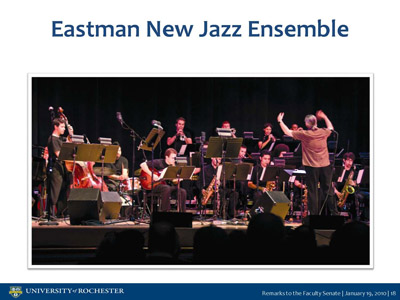
Down Beat, the “bible of jazz,” characterized the Eastman New Jazz ensemble as the best college big band in its annual music awards.
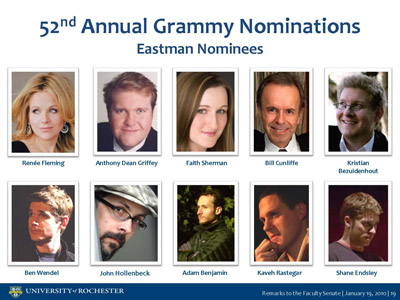
In total, Eastman faculty and alumni received ten Grammy nominations this year.
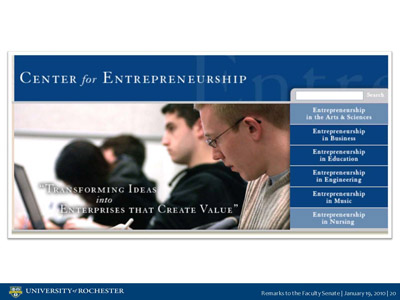
The Center for Entrepreneurship’s Master of Science in Technical Entrepreneurship and Management program is a finalist for the United States Association of Small Business and Entrepreneurship Outstanding Emerging Entrepreneurship Award.
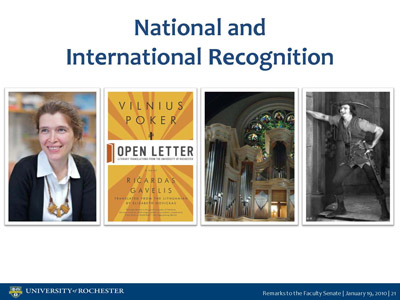
We have seen national and international recognition for several University faculty and programs, recently including the cancer and aging research of Professor Vera Gorbunova; Open Letter Books, our literary translation press linked to new academic programs in that field within the College; the new organ at Christ Church; and the “Robin Hood: Media Creature” conference organized by English professor Thomas Hahn.
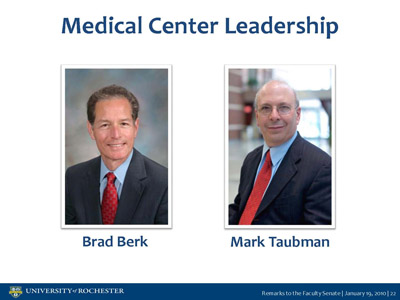
Earlier today I announced that Brad Berk will resume as Chief Executive Officer of the Medical Center on March 1. He has made a truly impressive recovery. On March 1, Mark Taubman, who has served so ably and well as Acting Chief Executive Officer, will begin service as Dean of the School of Medicine and Dentistry. Let me express my especial gratitude to Lissa McAnarney who has been Acting Dean for the last several months. Her performance in that role was outstanding. Mark announced earlier today that we will soon begin a national search for a new Chair of the Department of Medicine, the largest department in the Medical Center. Let me also express my gratitude to Paul Levy for serving so well as Acting Chair of the Department of Medicine. I am confident that these decisions will strengthen the Medical Center as it continues to implement its strategic plan and to provide outstanding clinical care and community service to our community and region.
I speak today at a time of national challenge.
Approximately one year ago, I addressed the Faculty Senate when our nation was experiencing what we now recognize was the beginning of the most serious economic emergency we have faced in the post-World War II period. It was already clear that the economy would affect the University during that and subsequent academic years for several reasons:
- Between July 1 and December 31, 2008, our endowment had declined by approximately 18 percent during a period when the Dow Jones Industrial Average had fallen by 21 percent.
- After three years of significant growth in philanthropy, we had witnessed a year to year 35 percent decline in cash received.
- The College anticipated the need to find and distribute more financial aid for our students and to have smaller tuition increases than in recent years.
- The New York State budget, then with a looming $15 billion deficit, appeared likely to make cuts in the growth of state Medicaid programs.
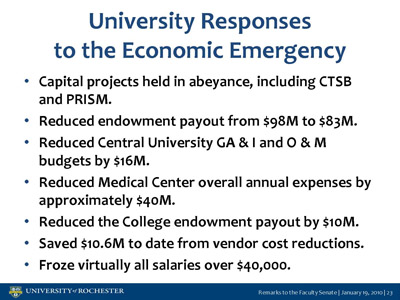
Each division of the University responded to the economic emergency:
- All capital projects then not yet begun were held in abeyance, including the Clinical and Translational Science and Pediatric Replacement and Imaging Sciences Modernization (PRISM) facilities.
- Total endowment payout was reduced from a planned $98 million to $83 million for the 2009-2010 academic year.
- The central University General Administrative & Institutional and Operations & Maintenance budgets were reduced by $16 million or 14 percent from the level approved by the Board of Trustees in the strategic planning process in October 2008.
- The Medical Center engaged in a systematic process which reduced its overall annual expenses by approximately $40 million.
- The College reduced its endowment payout by $10 million during an academic year when financial aid for undergraduates increased by 10.9 percent.
- Cost reductions were negotiated with University vendors that have resulted in savings of $10.6 million to date.
- Virtually all employees earning over $40,000 per year were subject to a pay freeze.
I emphasized then and reiterate today that the University is not in crisis and will emerge from this economic challenge well positioned for significant further progress. Our core missions, especially in education and health care, are vital to this country and will remain so.
One year later, however, the dominant reality we face is one of uncertainty. Indeed the one economic certainty that now is clear is that the current recession will last longer than any in the post-World War II period and recovery will be slower.
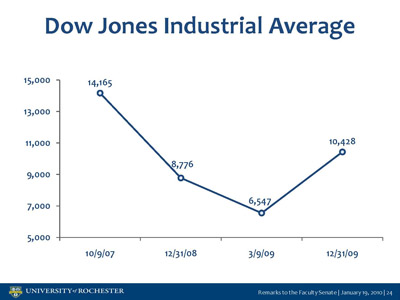
To be sure, there have been some hopeful signs. The stock market, which closed 2008 at 8,776 on the Dow Jones Industrial Average, rose 18.9 percent by December 31, 2009 and closed at 10,428. From its low of 6,547 on March 9, 2009, the Dow Jones Average rose 59 percent by year end.
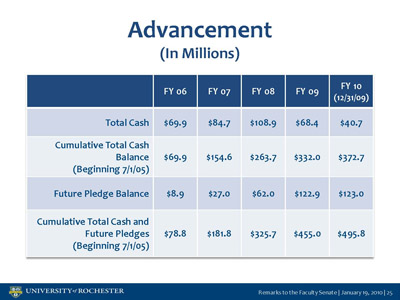
Support from our alumni and friends has started to pick up, with total cash support increasing by 11 percent between year end 2008 and year end 2009, including an annual fund increase of over 14 percent.
The debt markets have reopened and early this academic year we issued $117 million in tax exempt bonds. We subsequently were able to begin several capital projects, including the Clinical and Translational Science Building and phase one of Medical Center’s bed expansion project.
But balanced against these hopeful signs are highly concerning ones.
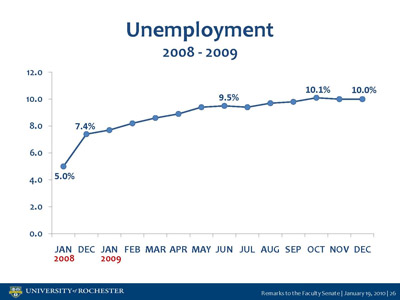
Unemployment remains heartbreakingly high at 10 percent and has been slow to decline despite a nearly $800 billion stimulus package early last year.
The finances of New York State remain in crisis with the likelihood that cuts will occur this year in health care and education.
Federal health care legislation now seems likely, which will be a very good thing in terms of extending care to millions of those who are now uninsured, but will have significant consequences over time for the financing of academic health care centers such as that at the University of Rochester.
Sponsored research support from programs such as the National Institutes of Health and the National Science Foundation runs the risk of “falling off a cliff” in fiscal year 2011 and returning to pre-ARRA levels if ARRA funding ends and the imperatives of deficit finance in Washington cause research to be flat funded or reduced.
More generally, uncertainty about future deficits, potential inflation, and rising health care costs has significant implications for future budgeting and planning.
For many universities, especially public universities, the combination of these types of factors has led to wrenching readjustments.
In July 2009, the California budget reduced support for the University of California system by $637 million or 20 percent, resulting in 2,000 U.C. staff members losing their jobs, the remaining staff and faculty being asked to take furloughs that amounted to pay cuts of 4 to 10 percent and undergraduate tuition being increased by 32 percent in one year.
Endowment dependent private universities have been less hard hit, but nonetheless have felt the impact of the economic emergency. Last academic year, the Consortium on Financing Higher Education (COFHE) reported that the 31 COFHE universities and colleges collectively experienced an average 25 percent endowment decline or a total of $45 billion. For some leading private universities whose budgets are significantly supported by endowment payout, such as Princeton (approximately 50 percent endowment support), Yale (44 percent) or Harvard (33 percent), the consequences of the decline in endowment value were particularly challenging.
Between 2008 and 2009, for example, Harvard’s endowment declined from $37 to $26 billion, resulting in a layoff of 275 employees.
Yale, facing an annual deficit of $150 million each year between 2011 and 2014, cut non-salary expenses initially by 7.5 percent and more recently by another 5 percent. Six hundred employees were laid off and construction projects worth $2 billion were postponed.
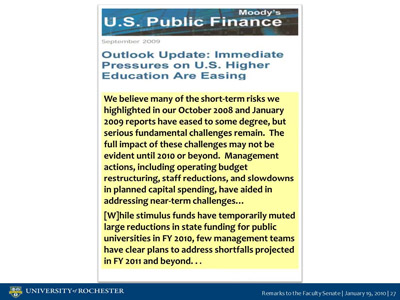
Generalizing, Moody’s in a September 2009 report stated: “We believe many of the short-term risks we highlighted in our October 2008 and January 2009 reports have eased to some degree, but serious fundamental challenges remain. The full impact of these challenges may not be evident until 2010 or beyond. Management actions, including operating budget restructuring, staff reductions, and slowdowns in planned capital spending, have aided in addressing near-term challenges…[W]hile stimulus funds have temporarily muted large reductions in state funding for public universities in FY 2010, few management teams have clear plans to address shortfalls projected in FY 2011 and beyond.”

Our situation at the University of Rochester is somewhat different. While we too will continue to have to make adjustments during a continuing national recession, these adjustments will not affect the core of our academic and clinical missions nor will they undermine the strength of our University.
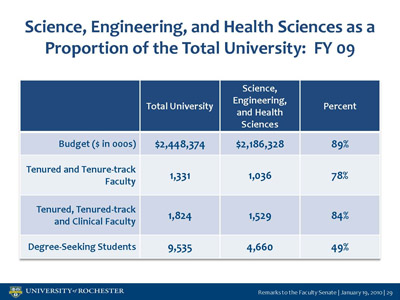
We begin with significant advantages. Our University is well aligned with an ongoing transformation of the national economy to a new knowledge basis. In 2009 the Bureau of Labor Statistics highlighted the professional and business services sector and health care as expected to add employment at more than twice the national average between 2008 and 2018, with 20 of the 25 fastest growing occupations expected to be in areas requiring a technology or health related education. In 2009, 89 percent of our annual budget, 78 percent of our tenured and tenure track faculty and 49 percent of our students were in the health professions, engineering, computer science, mathematics and natural sciences. Significantly, we also have achieved striking success in the performing arts, humanities, social sciences, business and education.
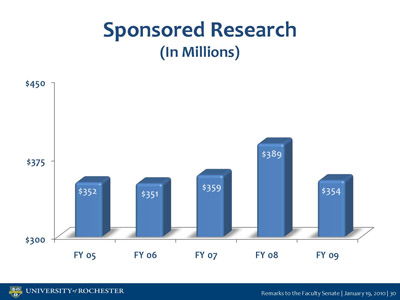
We continue to exhibit considerable strength in sponsored research. In 2009, the University received a total of $354 million from all sources other than ARRA funding. In FY 2008, we ranked 32nd for federally funded research and development expenditures and in 2007 26th for industry sponsored research and development expenditures. For the past eight years we have been among the top ten universities in the country in royalty revenues from patent licensing.
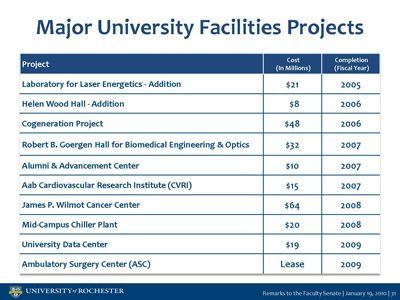
In the period since I began in July 2005, we have completed ten major University facilities projects with a construction cost of approximately $250 million, including the Robert B. Goergen Hall for Biomedical Engineering and Optics, the James P. Wilmot Cancer Center, the new University data center, the Cogeneration project, significant additions to the Laboratory for Laser Energetics, and a renovation of Kodak Hall in Eastman Theatre. Working with private developers, we have opened a new Ambulatory Surgery Center and added space for 400 students in Riverview Apartments just across the Genesee River – where we also are lead tenant in a new office building and there is a new hotel. We have initiated several other projects with aggregate budgets of approximately $330 million, including the expansion of the Eastman Theatre with a new wing, the Clinical and Translational Science Building and the Medical Center’s bed expansion project.
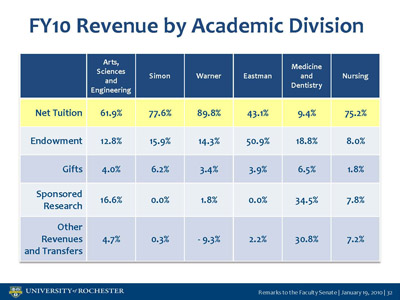
Our revenue base is less reliant on stock market volatility than many of our peers. In the current year, $83 million of our core academic budget of $446 million, or 19 percent, will come from endowment payout. For the College, School of Nursing, Simon Graduate School of Business and Warner School of Education, the most substantial support will be net tuition. In this academic year, 62 percent of the College budget, 75 percent of the School of Nursing, 78 percent of the Simon budget and 90 percent of the Warner budget are derived from tuition. In each school, there were impressive 2010 academic year application results.
I have heard expressions of concern about potential declines in future application or matriculation levels. I strongly believe that as an outstanding research university we will continue to do well. Unlike virtually all of the other 4,483 post-secondary institutions, the University of Rochester receives significant sponsored research support and is the beneficiary of extraordinarily competitive admissions applications. In the College, for example, last year there were over 12,000 applicants for an undergraduate class of 1,080.
At the same time, there remain fundamental strategic challenges for our University.
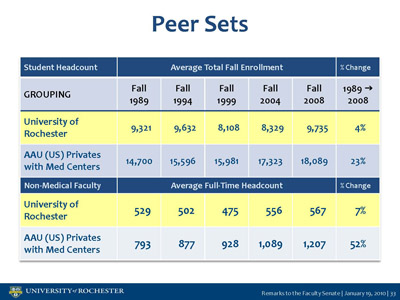
Our faculty and student aggregate size are smaller than virtually all of the other 18 Association of American Universities (AAU) private universities with medical centers, which I believe is our most useful peer set. In FY 2008, Rochester’s student enrollment of 9,735 comprised 54 percent of the average enrollment of this peer set, which was 18,089. The most critical reason to focus on student enrollment is that in tuition-driven schools student enrollment is a key factor in determining faculty size. As of 2008, our total nonmedical faculty was 567 or 47 percent of the average nonmedical faculty of the 18 AAU peer set. This datum is of particular concern. Between 1989 and 2008, the UR nonmedical faculty grew 7.1 percent compared to average growth among our peers of 52 percent. This creates a risk that we will be less able to hire and attract outstanding new faculty or to embrace cutting-edge academic programs. For this reason, I have stressed in our University strategic planning the theme of quality growth. Our strategic challenge is to simultaneously increase the size of our faculty and strengthen quality.
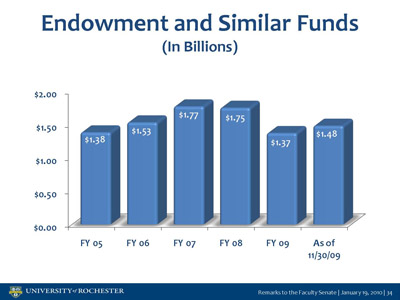
Our endowment and related funds were $1.48 billion as of November 30, 2009. In 2008, our endowment was 39th overall. Historically there has been some correlation between endowment and overall quality.
Against this backdrop, let me stress that implementation of our strategic plans will continue, but I want to highlight how the economy will affect our ongoing operations and the rate of implementation of our strategic plans.
During the next academic year, three key themes will characterize our efforts.
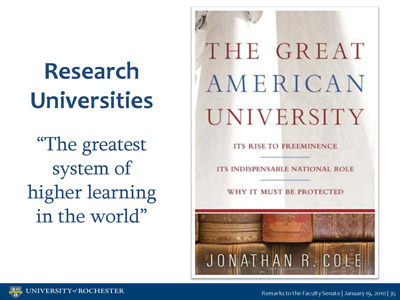
First, we will protect the core of our University. Loyalty to our students, our faculty, our staff and our patients is and must be our priority. I say this not merely because of my personal enthusiasm for those in the Rochester community, but because of a strong belief, as the former Provost of Columbia University Jonathan Cole, author of The Great American University, recently wrote, that the research universities of the United States constitute “the greatest system of higher learning in the world… Our finest [research] universities produce a very high percentage of the most important fundamental and practical discoveries in the world. This is true across the board: in the sciences and engineering, the social and behavioral sciences and the humanistic disciplines. Ambition to excel, and fierce competitiveness have led American research universities…to become the engines of our prosperity. The laser, magnetic resonance imaging, FM radio, the algorithm for Google searches, global-positioning systems, DNA fingerprinting, fetal monitoring, bar codes, transistors, improved weather forecasting, mainframe computers, scientific cattle breeding, advanced methods of public opinion, even Viagra had their origins in America’s research universities. Those are only a few of the tens of thousands of advances, originating in those campuses, that have transformed the world.”
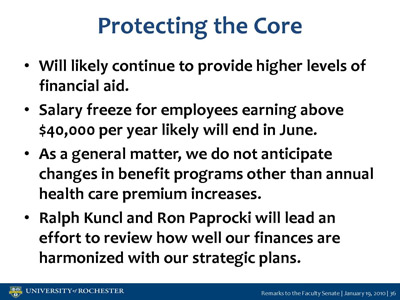
We will continue to provide higher than earlier budgeted levels of financial aid to our students in light of predicted high rates of unemployment into the next academic year. As I did last year, in a time of particular need for our students, I will increase my contribution to the University to $100,000 this academic year and direct that my contribution above my ongoing annual support of 10 percent of my base pay will be directed to student financial aid in our six schools.
Unless unexpected developments occur, the salary freeze for employees earning above $40,000 per year will end on June 30, 2010, although I give fair notice that next year’s salary increases may be more modest than in past years. For next year, as a general matter, I do not anticipate changes in benefits programs except for annual health care premium increases in January 2011. All of us in leadership at the University want to signal our support for our extraordinarily talented faculty and staff, but seek to do so in a way that minimizes job reductions and is sustainable.
I have asked Provost Ralph Kuncl and Senior Vice President for Administration and Finance Ron Paprocki to lead a review of how well our finances are harmonized with our strategic plans. I have been impressed by how lean a ship we currently are running. For example, a review of public tax returns from nine peer institutions with hospitals found that our 3.1 percent expense ratio for Management and General Expenses compared favorably to the mean of 7.8 percent. Nonetheless, in challenging economic times, it is important to make every effort to be as efficient as possible. For future years, they will systematically review relevant University and divisional expense and revenue categories. In some instances, the Kuncl-Paprocki review may recommend further efforts at cost containment. We seek to most effectively use our resources to support our priorities.
Inevitably, the impact of the ongoing recession will affect the rate of implementation of our strategic plans, but not our commitment to achieve them. As we proceed through this year’s annual budget reviews, a key focus for each academic division will be how to best harmonize challenging economic times with its strategic plan.
Second, we will rigorously review future capital projects, including new and renovated facilities and IT. We have had some significant recent success in pursuing creative strategies with respect to major capital projects.
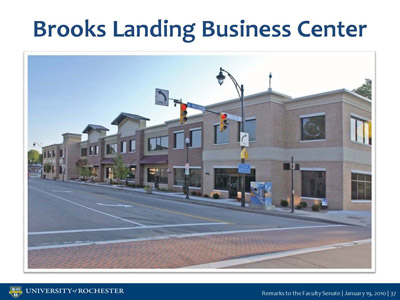
We worked with private developers on the Brooks Landing hotel-office building-student apartment project with the result that we have begun creation of a type of College Town adjacent to our River Campus but without University capital expense. This has allowed us to focus our capital resources on other University priorities. The approach used at Brooks Landing will be our model for development of the Mt. Hope Corridor, which potentially will add a second type of College Town adjacent to the Medical Center campus including retail, offices, residential and conference facilities. Last week we received responses from developers for our Request for Qualifications for this project. We were very pleased by the expressions of interest from several qualified national and Rochester area developers.
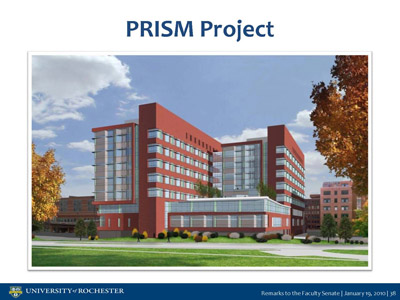
Our approach to the PRISM project is also an illustrative case study. Here the Medical Center leadership deserves enormous credit. In October 2008, our Board of Trustees conceptually approved a $262 million expansion of pediatric care, imaging, and adult beds at Strong Memorial Hospital within a new tower we call PRISM. The original plan contemplated $150 million in debt and completion of the entire project in one comprehensive facilities construction. When the economic emergency began, the Medical Center leadership made a second systematic review of clinical care needs. It remained as clear as it had before that there was an urgent need for more beds to address a patient occupancy crisis in our community. But the Medical Center adjusted its plans to financial realities. Construction of the new facility became a two-step process with a total budget of $208 million and an anticipated debt of approximately $100 million. The first phase of what was called the PRISM project will involve a three-story addition to the Wilmot Cancer Center and is now under way. This phase should be completed within 24 months and will provide considerable relief to the occupancy crisis. The ultimate PRISM project will involve a tower on the original footprint but reduced in square footage. Combined with the Cancer Center addition, the ultimate bed expansion project will provide approximately the same number of adult beds and exactly the same number of new pediatric beds as the PRISM project, but with reduced space for imaging facilities. This project galvanized strong support from the University senior leadership and the Board because it addressed most of the fundamental needs of the original PRISM project at reduced cost and preserved flexibility in its implementation.
Third, I will particularly work this year to focus on projects which strengthen our resource base.
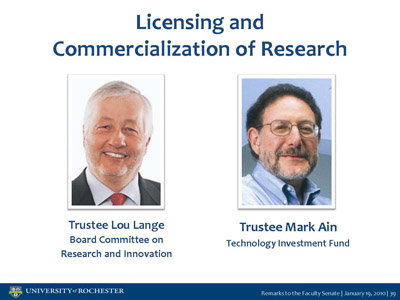
The Board of Trustees recently created a new Committee on Research and Innovation to be chaired by Trustee Lou Lange, and a separate Technology Investment Fund is being formed under the leadership of Trustee Mark Ain. Both the Board Committee and the Technology Investment Fund will address how we can further support the licensing or commercialization of University research.
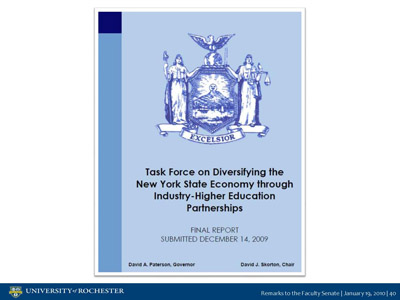
These efforts are well aligned with recent New York State initiatives. In December 2009, the State Task Force on Diversifying the New York State Economy through Industry-Higher Education Partnerships began: “The State of New York possesses many of the fundamentals to become a universally recognized world-class center of innovation. However, to realize its potential and achieve such a distinction, the State needs to develop an innovation ecosystem that efficiently and effectively unites universities, industry and capital.”
I am deeply supportive of these efforts when they are consistent with our academic mission, as I believe they can be. The Task Force report, for example, praised High Tech Rochester and Excell Partners, in which the University has had a leadership role. Even during a year of financial challenge, New York’s Governor Paterson committed himself to including a University Seed Fund in his proposed budget. This Fund will support early stage technology companies emerging out of University research.
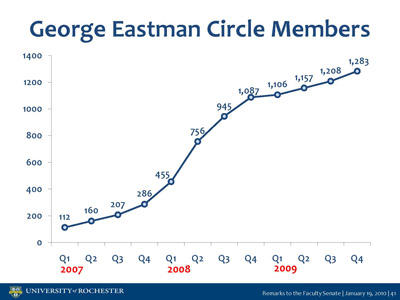
We are today 21 months from the public launch of the largest capital campaign in our history. This campaign will be my top priority this year as it has been for the past four and one half years. In the past four and one half years, we have raised $496 million in cumulative total cash and pledges. During that period Advancement began the George Eastman Circle, our leadership Annual Fund giving society, which by year end 2009 had grown to 1283 members and made our annual fund one of the fastest growing in the nation. We also have identified over 8,000 significant potential supporters of our University through the University Leadership Initiative and other means. By year end 2009, Advancement will have conducted over 50 focus groups around the country that have been instrumental in this effort. These results have been achieved despite our having made significant reductions in Advancement’s rate of growth as approved by the Board of Trustees during the current challenging year.
Capital campaigns such as ours have long-term time horizons. There inevitably will be periods of recession as well as periods of robust economic growth during a campaign which began here in a quiet phase the day I started, July 1, 2005, and is scheduled to continue until the end of the 2016 fiscal year. Assuming my continued good health and the support of the faculty and our Board of Trustees, I look forward to serving until this job is done.
Our challenge is to keep our eyes on the prize. We are a great university with extraordinary faculty, students, and staff. Enhanced resources will allow us to more fully achieve our strategic plans.
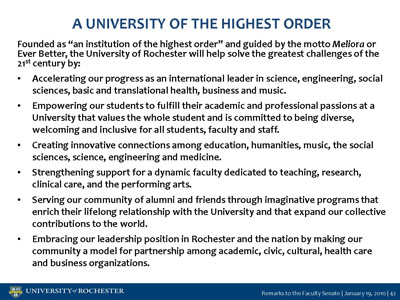
This year, the Board of Trustees, acting through its Strategic Planning Advisory Committee, and many senior University leaders, including the Faculty Senate Executive Committee, have worked to frame our Vision Statement for the campaign. A Vision Statement reflects our aspirations. Our Vision Statement is intended to articulate University wide goals. Each school and many departments and programs will develop more detailed campaign statements. We have sought in drafting the Vision Statement to limit its text to one page. The Vision Statement will be subject to a Board of Trustees vote at our March 2010 meeting. In its current draft, the University of Rochester Vision Statement states:
A UNIVERSITY OF THE HIGHEST ORDER
DRAFT: JANUARY 19, 2010
Founded as “an institution of the highest order” and guided by the motto Meliora or Ever Better, the University of Rochester will help solve the greatest challenges of the 21st century by:
- Accelerating our progress as an international leader in science, engineering, social sciences, basic and translational health, business and music.
- Empowering our students to fulfill their academic and professional passions at a University that values the whole student and is committed to being diverse, welcoming and inclusive for all students, faculty and staff.
- Creating innovative connections among education, humanities, music, the social sciences, science, engineering, and medicine.
- Strengthening support for a dynamic faculty dedicated to teaching, research, clinical care, and the performing arts.
- Serving our community of alumni and friends through imaginative programs that enrich their lifelong relationship with the University and that expand our collective contributions to the world.
- Embracing our leadership position in Rochester and the nation by making our community a model for partnership among academic, civic, cultural, health care and business organizations.
This text is not graven in stone. I welcome comments from all in the University community through February 5, 2010. Our vision of who we seek to be involves the entire University community.
This year will be a particularly significant one in our progress toward the largest capital campaign in our history. We will, for example, continue identifying potential supporters and work with our deans and academic leaders on a draft of overarching themes that connect our Vision Statement to the University’s Campaign Case Statement.
Last year we weathered an intense storm. Our economic challenges are not over. But our course is clear and our commitment to being a “University of the Highest Order” is unrelenting. The research universities that have been most successful in the post-World II period have been those that developed plans and stuck to them through thick and thin. I share the optimism and the patience of Susan B. Anthony. If we continue to proceed as one university, working together to implement our plans, “failure is impossible.”
